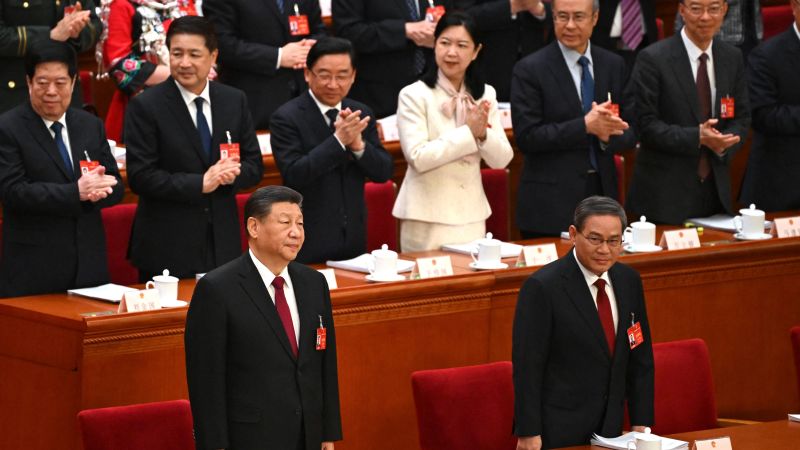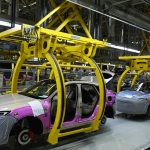Editor’s Note: Sign up for CNN’s Meanwhile in China newsletter which explores what you need to know about the country’s rise and how it impacts the world.
Chinese leaders have pledged to achieve an ambitious growth rate this year, while reshaping its economic model to focus on technology innovation.
But how Beijing will implement this vision remains unclear, and its resistance to any major stimulus measures to increase income and spur consumption has disappointed investors, sending them toward the exits.
On Tuesday, Premier Li Qiang announced that economic growth target of around 5% for 2024, which he said “will not be easy” to hit, given that a Covid-battered 2022 had provided a lower base of growth for last year. He also vowed to make industrial upgrading a priority and lean into tech innovation.
After the targets were announced on Tuesday, Hong Kong’s Hang Seng Index tumbled 2.6%. The index has fallen by about 1% so far this week and has lost nearly 20% over the past 12 months.
“The level of support is likely too little to rocket the economy to its 5% growth target this year,” said Sarah Tan, an economist at Moody’s, referring to the measures announced by Li Tuesday.
She said higher household spending was needed to put an end to deflation in China. Deflation refers to a sustained and broad decline in price levels for goods and services.
In January, consumer prices fell by the fastest rate in 15 years, marking a fourth straight month of decline. In 2023, prices rose by only 0.2% over the course of the year.
“The direct household transfers we were looking for” were a no-show, she added.
Beijing has refrained from launching massive projects to stimulate consumption and boost the economy in recent years. It offered none of the nationwide cash handouts seen in other major economies during the Covid-era.
While this has helped China avoid the rampant inflation experienced by much of the rest of the world, disposable household income has fallen as wages have stalled and property asset values have crashed.
China’s growth trajectory is of great concern for global investors and policymakers who have come to rely on it to drive global economic expansion.
But Beijing appears to be in a difficult position where it needs to promote growth while containing the level of government debt, which explains why stimulus measures have been modest.
Three years of strict pandemic controls, which ended at the beginning of 2023, and a real estate crash have drained local government coffers, leaving authorities across the country struggling with mountains of debt.
“China is walking a tightrope on the fiscal front between infrastructure stimulus and LGFV [local government financing vehicle] deleveraging,” said Goldman Sachs analysts on Wednesday.
The country’s experience from 2023 suggests “local governments may be falling short of capacity to stabilize growth given the unprecedented property downturn and higher debt pressure,” they added.
Li has set this year’s budget deficit at 3%, which was the same as the initial target for last year but lower than the revised final figure of 3.8%. He allowed local governments to issue 3.9 trillion yuan ($542 billion) worth of special bonds, which was at the lower end of the market forecast range of 3.8 trillion to 4.1 trillion yuan ($570 billion) and perceived to be a relatively modest amount.
These special bonds are mainly used for infrastructure spending.
To curb local government debt risks, Beijing instructed 12 heavily indebted local governments to delay or halt some state-funded infrastructure projects, according to a Reuters report in January, citing anonymous sources.
These 12 provinces contribute about 22% to China’s total infrastructure investment and 18% of gross domestic product (GDP), the Goldman analysts estimated.
Given this recent reported crackdown on local government debt, the still troubled property sector and 2023’s much higher base of comparison, “we think the ‘around ‘5%’ GDP growth target will prove very challenging,” Nomura analysts said on Tuesday.
On Tuesday, much of Li’s speech was devoted to the country’s strategic goals, including plans to boost the annual budget for science and technology by 10% to $51.6 billion, the biggest increase since 2019 after years of minimal growth.
The primary task of 2024 is to promote the construction of a modern industrial system and accelerate the development of “new productive forces,” he said.
“New productive forces” is a term coined by President Xi Jinping last year to refer to high tech sectors such as new energy vehicles, artificial intelligence, renewable energy and advanced manufacturing.
The inclusion of the term indicates Xi’s desire to promote the high-tech and green industries of the future and push the country ahead in the global race for critical technologies.
In the work report, Premier Li pledged to move the country up the global value chains and make “made in China” products more competitive.
“There was more emphasis on China’s long-term ambition to upgrade its industrial supply chain and enhance its manufacturing capabilities,” according to Peiqian Liu, Asia economist at Fidelity International.
But that talk alone won’t be enough. In order to achieve the ambitious 5% growth target, more specific stimulus is needed, such as increasing manufacturing investments, Liu said.
That leaves monetary policy — interest rates and other tools used by central banks — as the likely key weapon to stimulating growth.
On Wednesday, Pan Gongsheng, governor of the People’s Bank of China (PBOC), told reporters in Beijing that the bank has “rich” policy tools at its disposal and there is still room for further interest rate cuts.
The PBOC will maintain liquidity at reasonably ample levels this year and will focus on improving confidence and stabilizing prices, he said.
Last month, the PBOC cut its five-year loan prime rate by 25 basis points, the largest reduction since 2019.
“We see high likelihood [for the PBOC] to expand its balance sheet more than in 2023 via structural tools” to support specific sectors, such as tech, energy, and consumption, Jefferies analysts said in a note on Tuesday.
Read the full article here




